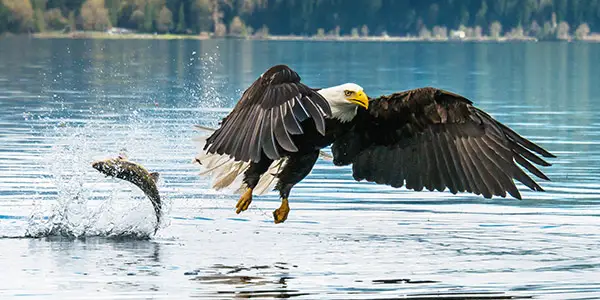The Bald Eagle: America’s Majestic Bird of Prey

The bald eagle (Haliaeetus leucocephalus) is more than just a symbol of the United States; it’s a majestic raptor with fascinating traits and a storied history. As the national bird and emblem of the U.S., the bald eagle commands respect and awe, but there’s much more to this magnificent bird than meets the eye. Let’s explore some of the most interesting facts about this iconic species.
1. Symbol of Strength and Freedom
The bald eagle was chosen as the national emblem of the United States in 1782, symbolizing strength, freedom, and resilience. Its impressive wingspan, which can reach up to 7.5 feet, and its powerful talons make it a fitting emblem for these ideals. The bald eagle’s striking white head and tail feathers contrast dramatically with its dark brown body, making it one of the most recognizable birds of prey.
2. Incredible Vision
Bald eagles are renowned for their exceptional vision. They have visual acuity estimated to be 4 to 5 times greater than that of humans. This extraordinary eyesight allows them to spot prey from as high as 3,000 feet in the air. Their keen vision is essential for hunting, as they primarily feed on fish but will also hunt birds, small mammals, and carrion.
3. Powerful Hunters
The bald eagle’s hunting prowess is unparalleled. Equipped with powerful talons and a sharp beak, it is a formidable predator. Its diet primarily consists of fish, which it snatches from the water with its talons while flying or hovering. Bald eagles are also known to steal food from other birds, a behavior called “kleptoparasitism,” showcasing their opportunistic nature.

4. Impressive Nesting Skills
Bald eagles are master nest builders. They construct large nests, known as eyries, typically in tall trees or on cliffs near water. These nests can reach up to 13 feet in diameter and weigh as much as a ton. Eagles use their nests year after year, adding new materials each season, which can result in incredibly large and durable structures.
5. Conservation Success Story
By the mid-20th century, the bald eagle faced severe threats from habitat destruction, hunting, and the effects of the pesticide DDT, which caused thinning of eggshells. This led to a dramatic decline in their population. However, thanks to conservation efforts and legal protections, such as the Bald and Golden Eagle Protection Act and the ban on DDT, the bald eagle population has made a remarkable recovery. In 2007, the bald eagle was removed from the U.S. Endangered Species list, marking a significant conservation victory.
6. Distinctive Mating Rituals
Bald eagles engage in impressive aerial displays during courtship. They perform a thrilling flight display known as “cartwheeling,” where the pair locks talons and tumbles through the air together before separating and soaring back up. This display not only strengthens their bond but also showcases their aerial agility and coordination.
Conclusion
The bald eagle is a symbol of power, freedom, and resilience. Its impressive physical attributes, extraordinary vision, and remarkable recovery from near extinction make it a fascinating subject of study and admiration. As a national symbol, it represents the spirit of the United States and serves as a reminder of the importance of conservation and protecting our natural heritage.
For more fascinating insights into wildlife and conservation, stay tuned to our blog. Next, we’ll explore another remarkable species and their role in the ecosystem.






